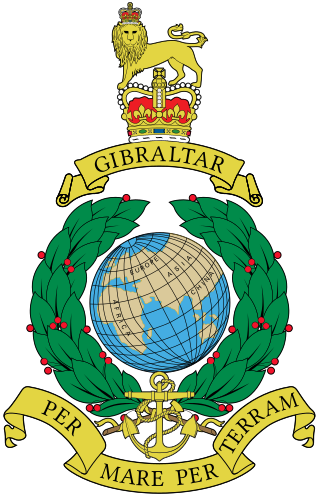
The Royal Marines, also known as the Royal Marines Commandos, and officially as the Corps of Royal Marines, are the United Kingdom's special operations capable commando force, one of the five fighting arms of the Royal Navy, and provide a company strength unit to the Special Forces Support Group (SFSG). The Royal Marines trace their origins back to the formation of the "Duke of York and Albany's maritime regiment of Foot" on 28 October 1664, and the first Royal Marines Commando unit was formed at Deal in Kent on 14 February 1942 and designated 'The Royal Marine Commando'.

3 Commando Brigade, previously called the 3rd Special Service Brigade, is a commando formation of the British Armed Forces. It is composed of Royal Marine Commandos and commando qualified personnel from the Royal Navy, British Army and Royal Air Force.

Commando Training Centre Royal Marines (CTCRM) is the principal military training centre for the Royal Marines. It is situated near the villages of Lympstone and Exton, between the city of Exeter, and the town of Exmouth in Devon, England.

Lympstone Commando railway station is a railway station situated on the Avocet Line, a branch line from Exeter to Exmouth in Devon, England.

45 Commando Royal Marines is a battalion sized unit of the British Royal Marines and subordinate unit within 3 Commando Brigade Royal Marines, the principal Commando formation, under the Operational Command of the Fleet Commander.

Royal Marines Barracks Chivenor is a British military base used primarily by 3 Commando Brigade. It is situated on the northern shore of the River Taw estuary, adjacent to the South West Coast Path, on the north coast of Devon, England. The nearest towns are Barnstaple and Braunton.

The Royal Marines Reserve (RMR) is the volunteer reserve force used to augment the regular Royal Marines. The RMR consists of some 750 trained ranks distributed among the four units within the UK. About 10 percent of the force are working with the Regular Corps on long-term attachments in all of the Royal Marines regular units. All the volunteers within the RMR must pass through the same rigorous commando course as the regulars. The former may be civilians with no previous military experience or may be former regular Royal Marines.

47 Commando Royal Marines, formerly 1 Assault Group Royal Marines, is a unit of Royal Marine Commandos that specialise in amphibious assault and raiding, as well as small boat operations, both amphibious and riverine. The unit falls under 3 Commando Brigade. In addition, it trains personnel for the Assault Squadrons of the Royal Marines (ASRM) and their landing craft detachments. It is based at RM Tamar in HMNB Devonport, Plymouth.

42 Commando is a subordinate unit within the Royal Marines 3 Commando Brigade. Based at Bickleigh Barracks near Plymouth, personnel regularly deploy outside the United Kingdom on operations or training. All Royal Marines personnel will have completed the Commando course at the Commando Training Centre (CTCRM) at Lympstone in Devon, entitling them to wear the green beret, with most attached personnel having completed the All Arms Commando Course.
The history of the Royal Marines began on 28 October 1664 with the formation of the Duke of York and Albany's Maritime Regiment of Foot soon becoming known as the Admiral's Regiment. During the War of the Spanish Succession the most historic achievement of the Marines was the capture of the mole during the assault on Gibraltar in 1704. On 5 April 1755, His Majesty's Marine Forces, fifty Companies in three Divisions, headquartered at Portsmouth, Chatham and Plymouth, were formed by Order of Council under Admiralty control.
The Royal Marines Volunteer Cadet Corps (RMVCC) is part of the Royal Navy's Volunteer Cadet Corps. There are units (Divisions) in Arbroath, Chivenor, Gosport, Lympstone, Portsmouth, and Plymouth.
41 Commando or No. 41 Commando was a unit of the Royal Marines trained as Commandos during the Second World War. They were part of the all Royal Marine 4th Special Service Brigade that took part in the Normandy landings in June 1944 and later that served in World War II, the Korean War, and in Northern Ireland. They were disbanded in 1981.

RM Condor is a large Royal Marines base located near Arbroath in East Angus, Scotland. The base also houses 7 (Sphinx) Battery Royal Artillery, part of 29 Commando Regiment Royal Artillery.

Major General Andrew Salmon, is a retired Royal Marines officer who served as Commandant General Royal Marines from 2009 to 2010.
Kate Louise Nesbitt MC is a pharmacy technician in the Royal Navy. Nesbitt was the first female member of the Royal Navy, and the second woman in the British Armed Forces, to be awarded the Military Cross (MC). The award was a result of her actions in Afghanistan in March 2009.
Royal Marines recruit training is the longest basic modern infantry training programme of any Commonwealth, or North Atlantic Treaty Organization (NATO) combat troops. The Royal Marines are the only part of the British Armed Forces where officers and other ranks are trained at the same location, the Commando Training Centre Royal Marines (CTCRM) at Lympstone, Devon. Much of the basic training is carried out on the rugged terrain of Dartmoor and Woodbury Common with a significant proportion taking place at night.

Stonehouse Barracks, or RM Stonehouse, is a military installation at Stonehouse, Plymouth. It is the home of 3 Commando Brigade and referred to by commandos as 'the spiritual home of the Royal Marines'.

The Royal Marine Depot, Deal was a military installation occupied by the Royal Marines and located in South Deal, Kent, on the road to Walmer. The Depot was first established in Deal in 1861, occupying part of the Royal Naval Hospital. In 1868 the Depot expanded and took over the nearby 18th-century Army barracks.
The Volunteer Cadet Corps (VCC) is a national youth organisation managed by the United Kingdom's Royal Navy and sponsored by the UK's Ministry of Defence. The VCC comprises:













